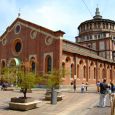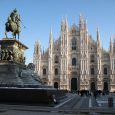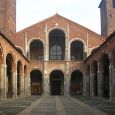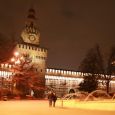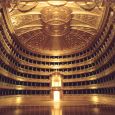Milan
Advertisement
By Air
Milan is served by two airports, Milan Malpensa Airport and Milan Linate Airport. Malpensa is the main airport, receiving the bulk of the traffic and international flights, while Linate Airport is the main hub for domestic flights. From Malpensa Airport, trains run to the city centre every 40 minutes, while shuttle buses including an express service and expensive taxis also provide access. Local buses, shuttles and taxis provide city access to the city centre from Linate Airport.
By Rail
There are three main stations in Milan: Stazione Centrale (Piazza Duca d'Aosta), Stazione Nord and Stazione Porta Garibaldi. Stazione Centrale is the main station, with services arriving from all over Italy including daily trains from Venice (3 hours, 30 minutes); Florence (3 hours, 30 minutes); Turin and Genoa (90 minutes); Rome (6 hours); and Naples (8 hours). International trains also arrive here from Switzerland and France, while the other two stations receive important regional services including from the likes of Como.
By Bus
Buses take longer than trains and can be more expensive within Italy, with the excellent rail connections with neighbouring France and Switzerland negating the need for cross-border bus travel.
However, Eurolines buses run to Milan from destinations throughout Europe and arrive at Autostradale in front of the Castello Sforzesco near Cairoli metro station. Intercity buses also run to and from this station, with daily services arriving from all over Italy.
By Car
Motorways converge on Milan from every direction, making it very accessible from the rest of Italy as well as from Switzerland and France. Major access roads include the A1, which links Milan with Florence and Rome; the A4, which connects Verona and Venice (east) and Turin (west); while the A7 comes in from Genoa to the southwest and the A8 arrives from the Swiss border to the northwest. Driving in Milan can be tough due to many pedestrian thoroughfares, parking difficulties and congestion.
Cathedral of Santa Maria Nascente
The cathedral of Santa Maria Nascente, a cruciform basilica faced with white marble, is one of the world's largest and most magnificent churches. With a length of 157m/172yd and a facade 61.5m/67yd wide, it covers an area of 11,700 sq.m/13,993 sq.yd and can accommodate a congregation of 40,000. The dome rises to 68m/224ft, and its total height including the statue of the Virgin known as the "Madonnina" is 108.5m/358ft. The roof is adorned with 135 pinnacles, the exterior with 2,245 marble statues. Building, in Gothic style, began in 1386 but made slow progress (dome completed c. 1500, spire 1765-69, facade under Napoleon 1805-13). The imposing bronze doors are modern: the one to the left dates from 1840 and the large central door from 1908 the reliefs on two other doors were carried out between 1948-51, and the last one in 1965.
Sant'Ambrogio
The church of Sant'Ambrogio east of the National Museum in Milan was founded in 386 by St Ambrose. The present church is a masterpiece of Romanesque architecture (12th century; choir ninth century). Notable features of the interior are the pulpit, restored about 1200, with late Romanesque carving, and the casing (paliotto) of the high altar, a masterpiece of Carolingian art
Santa Maria delle Grazie
In the refectory of the former Dominican monastery is Leonardo da Vinci's "Last Supper" (the Cenacolo Vinciano), his most famous work, painted on the wall in tempera between 1495 and 1497: a dramatic presentation of the scene which was quite novel and marked an important new stage in the development of art. The painting is much damaged from the flaking off of the paint and during the last decades has been restored several times, a process which will probably never be fully completed.
Castello Sforzesco
The Castello Sforzesco, held successively by the Viscontis and the Sforzas, was built in 1368, demolished by the people of Milan in 1447 and rebuilt from 1450 onwards. The Torre de Filarete, on the nearside (70m/231ft high), is a reproduction (1905) of the original gate-tower.
Teatro alla Scala
In Piazza della Scala is a monument to Leonardo da Vinci (1872). On the northwest side of the square stands the Teatro alla Scala (1775-78).
La Scala is among the most-celebrated opera houses in the world. It was originally built on the site of the 14th century church of Santa Maria della Scala. The theater seats 2,800 and attracts one of the most demanding audiences in Italy. The season begins in early to mid-December and runs through May but tickets are often difficult to come by. Check with your hotel concierge or visit the box office. You may get lucky and find some seats available up in the gallery.
If you are in Milan out of season you can still visit the Museo Teatrale alla Scala in the same building from where you can view the inside of the opera theater. The museum honors the greats who performed and whose works were performed at La Scala including Verdi, Rossini and the great conductor Arturo Toscanini.
Information not available


